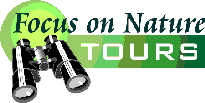
E-mail: font@focusonnature.com
Phone: Toll-free in USA 1-888-721-3555
or 302/529-1876
 |
PO
Box 9021, Wilmington, DE 19809, USA E-mail: font@focusonnature.com Phone: Toll-free in USA 1-888-721-3555 or 302/529-1876 |
HighlightS
FROM PREVIOUS
FOCUS ON NATURE TOURS
in the Cayman
Islands
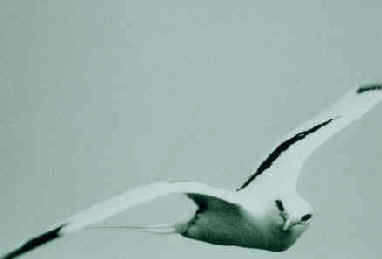
A White-tailed Tropicbird
as seen and enjoyed during FONT tours
in the Cayman Islands
(photo by Alan Brady)
The
following summaries here are given with the most-recent tours first.
For some tours there are links below for longer narratives. Also there are links
to UPCOMING TOUR ITINERARIES, and lists (some with photos) of BIRDS, MAMMALS,
and OTHER NATURE.
Some Previous Tours:
December 2010 February/March 2006
In
all, there have been 6 FONT tours in the Cayman Islands
Links:
Cumulative list of Birds during previous FONT Cayman Island Tours
Upcoming
FONT Birding & Nature Tours in the Caribbean including the Cayman Islands
A Bird-List & Photo Gallery of Caribbean Birds,
in 2 parts:
Part #1: Guineafowl to
Hummingbirds Part #2: Trogons to Buntings
Butterflies & Moths in the West Indies of the Caribbean
Amphibians & Reptiles in the West Indies of the Caribbean
Tropical Plants of the Americas, including those on Caribbean Islands
![]()
This tour in early
December 2010 was to a small, but interesting, island, Grand
Cayman, in the middle of the blue Caribbean Sea. About 200 miles
south of Cuba, and over 150 miles west of Jamaica, that island is out there by
itself, except for the two accompanying islands in the group of 3, Little Cayman
and Cayman Brac.
Of the 3 Cayman Islands, Grand Cayman is, (although as noted as small), the largest
of the 3 with 123 square miles.
Whether perceived as "small" or "large", as already noted
also, Grand Cayman Island
is interesting, with a mix of habitats: dry forest, dry scrubland, seasonally
flooded wetlands, and extensive mangroves.
In that mix on the Cayman Islands, there are, incredibly, 415 types of plants
believed to be native, and among them about 30 that are endemic and about
25 near-endemic. Now, that is interesting!
And that relates to the flora. There's also the fauna. I'll
mention both here, but the flora first:
We saw a number of those native and endemic plants during our tour, including
the Agave caymanensis, Dendrophylax fawcetttii (the critically
endangered Ghost Orchid), Coccothrinax proctorii (the Silver
Thatch - the endemic "national tree" that played such a part
in the island's history), and Hippomane mancinella, the Manchineel,
a tree that, in all of its parts, is very poisonous to man, but with a fruit
that can be eaten by the rare Cayman Blue Iguana.
That reptile is said to be the rarest of the world's iguanas. Native to Grand
Cayman Island, it is now considered to be a subspecies of the Cuban Iguana,
Cyclura nubila lewisi.
Many of the native plants and animals of the Caymans are derived from species on
Cuba, Jamaica, and to a lesser extent, Central America.
Among the amphibians and reptiles during our December
2010 tour, in addition to the iguana, there were, clinging on
large leaves, the Cuban Treefrog, and seen on the ground, the Cuban
Racer, or Ground Snake. The snake was the endemic subspecies on Grand
Cayman Island, Alsophis cantherigerus caymanus.
Among the birds of the Caymans, that we enjoyed during our tour, were
these that occur more commonly in Cuba: the Rose-throated Amazon, Cuban
Bullfinch, LaSagra's Flycatcher, and Western Spindalis.
We saw, nicely, the Yucatan Vireo. Grand Cayman Island is the only place
for that species outside of Mexico and nearby Belize.
The Vitelline Warbler is virtually endemic to the Caymans (otherwise
being only on the isolated Swan Island). And, also during our
tour, we saw about as many as 300 West Indian Whistling Ducks, a species
that globally is rare and elsewhere can be difficult to find.
And there were the unexpected, very unexpected: as we were waiting one
evening, at sunset, for Velvety Free-tailed Bats to leave their
daytime roosting sites, an Eastern Whip-poor-will flew by and a King
Rail called in the nearby tall reeds of a small marsh. Both the whip-poor-will
and the rail are very rare birds in the Caymans (in fact, not even on
the island's bird-list), but they occur in December as either a vagrant in
Cuba and Jamaica (the rail) and (with the whip-poor-will) as a
rarely-observed transient in Cuba on its way to spend the winter by the
Caribbean coast of northern Central America.
Conversely, very easy to observe in the Caymans are butterflies - always
a natural highlight of a visit there, and they were for us again in December
2010, with dozens of Julias (or Flambeaus) at one
place, and a number of other species including the Cuban Red Leaf Butterfly,
Gulf Fritillary, White Peacock, Caribbean Buckeye, the Soldier,
Western Pygmy Blue (possibly the smallest of the world's butterflies),
and the Hanno Blue and Lucas's Blue (closely related to the
rare Miami Blue of south Florida).
Also in the "insect-department" during our December
2010 Cayman Tour, we saw a diurnal moth that looks so much
like a small hummingbird, even having a white band on the lower back as do the
small hummingbirds called coquettes. That moth, that we saw feeding at flowers,
has, of course, a scientific name: Aellopos tantalus. Its English name
is, correspondingly, the Tantalus Sphinx Moth.
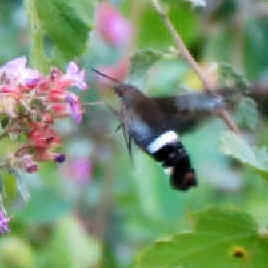
The Tantalus Sphinx Moth,
much like a hummingbird
Also, during our tour, there was the large caterpillar that we saw that would turn into
a moth. Over 4 inches long, that big, fat caterpillar was, and filled with
color: bright yellow, black, and with a red head. Scientifically it goes by the
name Pseuosphinx tetrio, to be the large Tetrio Sphinx Moth.
During a previous FONT tour in the Caymans, that was in the month of February,
we saw that big moth, flying about after dark, as the headlights of our vehicle
shone on it, when we were on a dark back road.
That road, by the way, was not
far, as the moth would fly, from where we saw the caterpillar, a couple years
later, in December
2010.
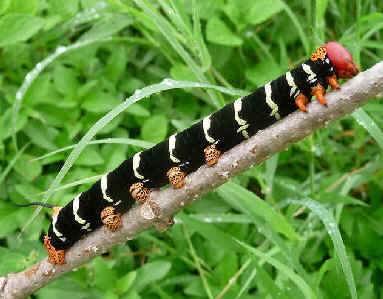
The caterpillar of the Tetrio
Sphinx Moth
We look forward, in the years ahead, to going to the Cayman Islands again for the fine assortment of
nature to be had there, on a Caribbean island both pleasant and comfortably
warm.
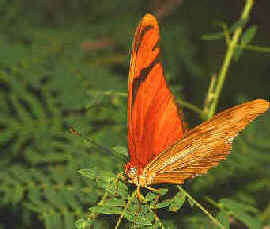
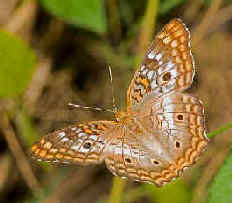
Two of the butterfly species
during our December 2010 Cayman Tour,
the Julia (above) & the White Peacock (below).
Links:
A
List
of Birds & Other Nature during the FONT Cayman Islands Tour in December 2010
![]()
During the FONT tours in February/March 2006 to
these islands (that could be done
either in combination or separately), a nice number of Caribbean endemic
& specialty birds were seen.
Highlights in the Caymans included well over a hundred West Indian
Whistling-Ducks and a colony of a couple thousand Red-footed Boobies
& Frigatebirds, in addition to "target birds" such as Rose-throated
Parrot, Yucatan Vireo, Cuban Bullfinch, and Vitelline Warbler.
Among the best in Jamaica, in addition to the endemics, were a pair of Masked
Ducks, a fine look at a Yellow-breasted Crake, and about 20
White-tailed Tropicbirds seen nicely as they flew close to us cliff-side.
Links:
More about the FONT tours in the Cayman Islands & Jamaica in February/March 2006
List
of Birds during our tours in the Cayman Islands & Jamaica - February/March
2006